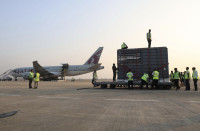Columns
Enhancing access to finance for women
As a first step, we need to identify the actual needs and study international practices.
Shreya Subedi
Entrepreneurship, traditionally a masculine career path, is now changing its course and embracing women. The Federation of Women Entrepreneurs Association Nepal states that there are currently 500,000 self-employed women entrepreneurs in different occupations and services across the country, providing 50,000 jobs. According to the recent National Economic Census published by the Central Bureau of Statistics, women-owned 29 percent of the 922,356 establishments in the country. The change is apparent, but many obstacles remain for women entrepreneurs.
Apart from social and cultural barriers that limit women from entering this path, another major obstacle is access to finance. Women entrepreneurs generally find it challenging to raise capital or obtain a bank loan. A study by HSBC Private Banking entitled She’s The Business has revealed that more than one-third of female entrepreneurs face gender bias while raising capital for their businesses. Other gender-specific challenges such as lack of collateral and less control over assets also play a significant role while accessing formal credit for women. Only 26 percent of women have access to property rights, according to the Central Bureau of Statistics. Small and medium-level entrepreneurs also find it difficult to get access to finance. The Federation of Small and Medium Enterprises Nepal says women own 60 percent of Nepal's small and medium-sized enterprises.
Numerous initiatives
The government of Nepal has introduced many initiatives, policies and micro-financing schemes to create a more conducive environment for women entrepreneurs, like the Civil Code Bill, which entitles equal property rights to both daughters and sons, 15 percent income tax exemption for enterprises with more than 50 percent native women employees, and collateral-free loans at 6 percent interest. The Covid-19 pandemic deeply impacted women entrepreneurs and their businesses. In an attempt at reviving enterprises, the 2020 Monetary Policy introduced by the government contained various provisions for small and medium enterprises, like credit at a maximum of 5 percent interest for micro, cottage and small industries. Development banks and financial institutions are required to mobilise 20 and 15 percent respectively of their total credit portfolio to micro, cottage and small-scale industries for the next five years. The 2021-22 budget has also included various tax exemptions and incentives for Covid-19 affected businesses.
Despite these provisions designed to help women entrepreneurs to flourish, they have not been as effective as anticipated. According to a report by UKAID, banks are hesitant to lend to women because they lack property that can be used as collateral, even though they are required to issue credit without collateral.
The promotion of uncollateralised lending and project financing schemes for women-run enterprises can be effective, according to a policy priority report published by the Federation of Women Entrepreneurs Association Nepal. Loan applications can be evaluated on various factors such as business potential and deposit history rather than past track records and collateral. First Women’s Bank, one of the two banks in Pakistan that provide solutions to women's financial needs, sends a financial bank officer to visit the business site and evaluate and appraise the application. Women business associations can host business growth competitions targeted at women-owned small and medium-sized enterprises and in cooperation with financial institutions, offering loans or grants to selected winners. This could help banks analyse the potential of the enterprises and their products.
Testing innovative risk evaluation methodologies, such as psychometric screening developed by the Entrepreneurial Finance Lab at Harvard University, which evaluates the risk of lending to an entrepreneur based on personality, intelligence and character as opposed to traditional credit history, and offers interest rates commensurate with new risk profiles, could be helpful. A pilot exercise conducted by the fifth-biggest bank in Peru on the Entrepreneurial Finance Lab tool (an alternative credit information tool to screen loan applicants that uses the psychometric application to predict entrepreneurs repayment behaviour) concluded that the tool was feasible for micro, small and medium enterprises, and could add value to traditional credit-scoring methods in different ways for both banked and unbanked entrepreneurs.
The World Bank analysed psychometrics as a tool to improve screening and access to credit and concluded that the Entrepreneurial Finance Lab could improve credit scoring models and increase market confidence in credit scores. The availability of limited specialised financial products is another issue identified by UKAID. For this, financial products based on the needs of women entrepreneurs after proper market research could be useful and effective to capture the needs and address women's access to finance. This has been effective in Lebanon, where, after introducing financial products based on market research of women entrepreneurs' needs, BLC Bank saw a 55 percent rise in their loans.
Closer to home
Access to finance is a persistent problem for Nepali women entrepreneurs. Despite numerous schemes that have been introduced thus far, having access to easy and accessible funding remains difficult. The Nepal government also introduced the Integrated Subsidised Loan Scheme to address the issue of access to finance. But the need for additional specialised financial products targeted towards women entrepreneurs remains. Banks and financial institutions, along with the government, international organisations and civil societies, can explore and take inspiration from global financial models to create an effective scheme for women entrepreneurs in Nepal.
It is not an easy feat, but slow and steady steps can be taken. The first step can be research—research on international practices and the actual needs of women entrepreneurs in Nepal. This can help identify the actual needs of women entrepreneurs, and international practices can help decide and select useful products. The second phase can be selecting banks and introducing pilot projects to assess the success of products, similar to what was done in Peru. Researching and introducing new financial products based on the needs and conditions of women entrepreneurs can help accelerate ease of access to finance and develop the quality of women entrepreneurs in Nepal.




 14.12°C Kathmandu
14.12°C Kathmandu













%20(1).jpg&w=300&height=200)

